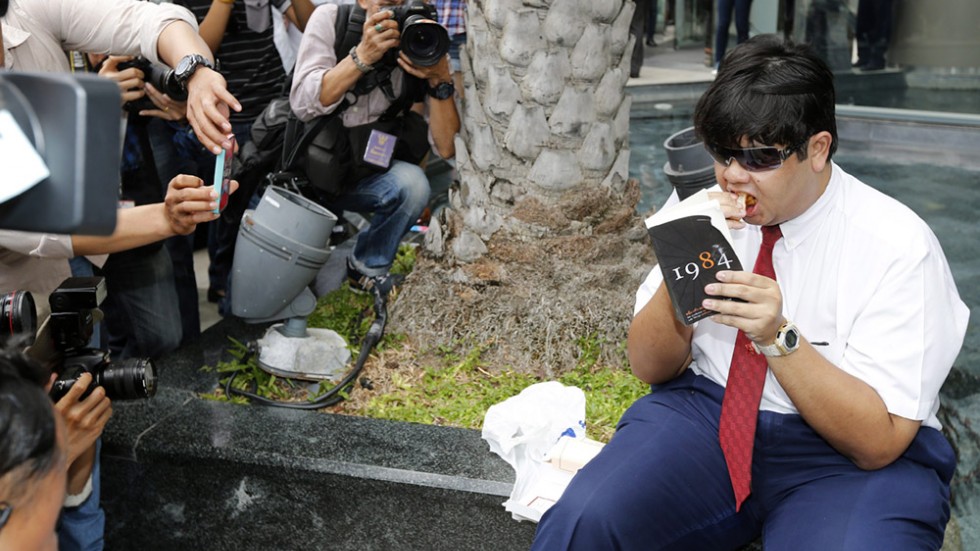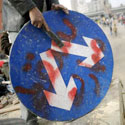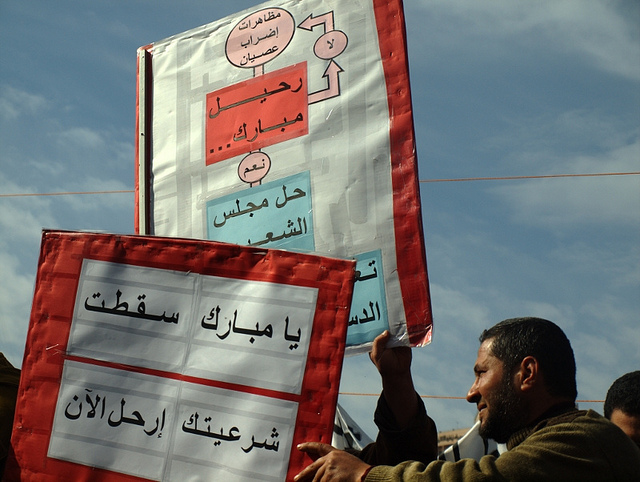egypt
After Nineteen Eighty-Four
Towards an ironic history of George Orwell's novel Nineteen Eighty-Four, a book about pervasive surveillance and censorship under totalitarianism.

“An Egyptian college student carrying a copy of George Orwell’s novel ‘Nineteen Eighty-Four’ was arrested in Cairo, raising questions about free speech under the country’s government with President Abdel Fattah Sisi.”
“Thailand has suppressed the film of Nineteen Eighty-Four, George Orwell’s classic novel of dictatorship and surveillance, in the latest effort to quash dissent after last month’s military coup. Members of a film club in the northern city of Chiang Mai cancelled a screening of the film in an art gallery after police intimidated organisers with suggestions that it violated the law. Nineteen Eighty-Four has become a symbol of peaceful opposition to General Prayuth Chan-ocha, who seized power from Thailand’s elected government last month after months of violent street demonstrations.”
“Police in Thailand yesterday arrested eight people for demonstrating against the nation's increasingly repressive military junta, including a man dragged away by undercover officers for reading a copy of George Orwell's Nineteen Eighty-Four.”
“In George Orwell’s ‘1984,’ government censors erase all traces of news articles embarrassing to Big Brother by sending them down an incineration chute called the ‘memory hole.’ On Friday, it was 1984 and another Orwell book, Animal Farm, that were dropped down the memory hole — by Amazon.com. In a move that angered customers and generated waves of online pique, Amazon remotely deleted some digital editions of the books from the Kindle devices of readers who had bought them.”
“The [CIA] also changed the ending of the movie version of ‘1984,’ disregarding Orwell’s specific instructions that the story not be altered. In the book, the protagonist, Winston Smith, is entirely defeated by the nightmarish totalitarian regime. In the very last line, Orwell writes of Winston, ‘He loved Big Brother.’ In the movie, Winston and his lover, Julia, are gunned down after Winston defiantly shouts: ‘Down with Big Brother!’”
“It was banned and burned in the U.S.S.R. under Stalin’s rule for its’ negative attitude toward communism, and reading it could’ve resulted in your arrest. It has also been banned and challenged in many U.S. schools. During the Cold War, a teacher in Wrenshall, Minnesota was fired for refusing to remove 1984 from his reading list. In 1981, it was challenged in Jackson County, Florida (for being pro-communism!).”
Tahrir, Revolution, and Design
Stunning photos today of the millions of Egyptians out in the streets to commemorate the start of the revolution a year ago that turned out Mubarak — and to demand transition from military to civilian rule.
A few things have been written on the supporting role of design in the revolution and the urban landscape as both site and medium of protest:
- The role
of protest signage
- Graffiti and murals
- Planning, public squares and cities as tools of rebellion
- Flyers, manifestos and ephemera
- Cellphone cameras and social media
- Even product labeling.
But I think my favorite detail is in this annotated overview of Tahrir square by BBC News.
The authors of direct action (particularly in West Asia and North Africa) are often depicted as a rowdy mob of thugs. But instead of the usual sea of angry Arab men so often shown by the mainstream media, the photo shows a kindergarten set up in the square. Schools in Cairo had been closed during the protests, but many mothers wanted to attend the demonstration as well. So demonstrators organized an impromptu kindergarten.
The image captures the spirit of mutual support that sprang up around the occupation. And my favorite detail: the newsprint under the paintings to keep the square, the city and country they love, free from spills. No random acts of violence here, but using the city to create something new, a different future, with hope and love.

Those Other Egyptian Protests

Over at Counterpunch, Esam Al-Amin breaks down key moments in the Egyptian revolution including this wonderful tactic: publicizing fictional protests while the real one(s) assembled:
“Since at least 2004, Egypt has witnessed many protests... In every case, the demonstrators were outnumbered by the security forces, which brutally cracked down on them, causing numerous injuries and arrests.
But the Tunisian revolution changed that equation in several ways. First, it inspired Egyptians beyond the activists or elites. Secondly, once the youth organizers decided to take to the streets on January 25, they outsmarted the security forces.
As a ruse, the youth released announcements for people to gather at certain landmarks and intersections knowing full well that massive security forces would be awaiting them there. Instead, they went in small groups to side streets in poor and middle class neighborhoods with no government agent presence to mobilize these areas to join the protests.
[One of the organizers recounts:] ‘I went to a street in Bulaq Dakrur (one of the poorest neighborhoods in Cairo), where I and a group of members from the movement intended to start protesting. At the same time, other members were doing the same thing in other areas. When we had assembled, we raised the Egyptian flag and began to chant slogans, and it was surprising when a large number of people joined us. This prompted us to take our demonstration down Gamat al-Dawal al-Arabia Street (main street). With increasing numbers joining us, we stopped for some time in front of Mustafa Mahmoud Mosque (major landmark), and then we led the march to Tahrir Square. We found several demonstrations coming from different areas towards this area, and thus we decided to occupy Tahrir Square.’
To the complete surprise of the security forces, the demonstrators reached Tahrir Square numbering over one hundred thousand, which they could neither control nor disperse. Despite the existence of thousands of security forces, this was a new situation that they had not experienced before.”
Egypt Infographics
A protester breaks down the algorithm: “Mubarak leaves. Yes: Parliament dissolves. No: Protests, disobedience. strikes.”
One of the Creative Commons photos posted to the Flickr stream of Al Jazeera English.
Egypt's Tears

Via Facebook: photo of a tear gas canister from a police crackdown on protesters in Egypt.
The label: “Made in U.S.A.”
When Design Stopped the War
“But does it work?”
It’s one of those frequently asked questions one often hears at discussions of design and activism. That and the whole preaching to the converted thing. It refers to design specifically, but also protest generally.
It sometimes takes a long time to stop a war, but now and then the impact is immediate. Like the time in February 1998 when protestors disrupted an internationally broadcast “Town Meeting” on Iraq at Ohio State University. Students dropped a NO WAR banner in front of an CNN’s rolling cameras and made such a ruckus that the moderator had to allow them a turn at the mic. Their pointed questions about the war embarrassed the Clinton Administration, tipped public and international support, and prevented an invasion of Iraq. “Not even Ohio supports the bombing, Egyptian President Hosni Mubarak said a few days later. Why should Egypt?”
Of course, it wasn’t this one protest alone, nor solely the banner smuggled into the event. But the action, broadcast around the world via cable news, sealed the deal. Katha Pollit’s March 1998 article tells the story.
Update 3/16/2010: Here’s a transcript of the town hall meeting.
 Screw the Flash game, since a pair was hurled at President George W. Bush the Model 271 shoe is flying off the shelf. “Baydan Ayakkabicilik San. & Tic. has received orders for 300,000 pairs of the shoes since the attack, more than four times the number his company sold each year since the model was introduced in 1999.... ‘Model 271’ is exported to markets including Iraq, Iran, Syria and Egypt. Customers in Iraq ordered 120,000 pairs this week and some Iraqis offered to set up distribution companies for the shoe, Baydan said.” More on The NY Times.
Screw the Flash game, since a pair was hurled at President George W. Bush the Model 271 shoe is flying off the shelf. “Baydan Ayakkabicilik San. & Tic. has received orders for 300,000 pairs of the shoes since the attack, more than four times the number his company sold each year since the model was introduced in 1999.... ‘Model 271’ is exported to markets including Iraq, Iran, Syria and Egypt. Customers in Iraq ordered 120,000 pairs this week and some Iraqis offered to set up distribution companies for the shoe, Baydan said.” More on The NY Times.
A good use case to add to the repertoire of texting and activism. It’s like your own personal urgent action network. Thank you, Blaine!
Update: See this Wired item on using Twitter to coordinate events, rumor control and public safety during direct actions against the war in San Francisco.


